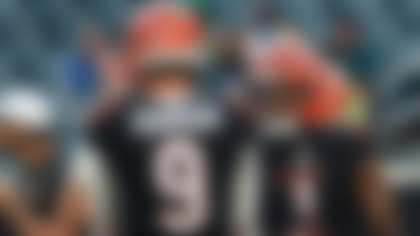As the unified start to NFL training camp nears, some notable free agents remain available for teams to snag. In fact, the four players listed below provide production potential that's extremely rare to see this late in the offseason. Of course, this at least partially stems from this year's reduced salary cap, a pandemic-induced development that has spawned an abnormal version of musical chairs across the league.
While I'm not privy to true cap or health situations, I matched each of the following free agents with an organization that would maximize his projected win share. Think of win share like WAR in MLB or PER in the NBA -- basically, it's how much each individual drives a team's win total. I simulated the entire 2021 NFL season with these players on their prospective teams. As you can see, the pairings are presented according to projected win share, from highest to lowest.
ONE LAST NOTE: While you're sure to recognize the highly accomplished players below, you'll also probably notice that one big-name free agent isn't included. I initially had Richard Sherman reuniting with Robert Saleh on the Jets. But with news breaking of Sherman's arrest on a charge of burglary domestic violence, I removed him from this exercise.

PROJECTED WIN SHARE: 0.71 wins
Last season, Kansas City pressured opposing quarterbacks on just 23.3 percent of dropbacks (23rd in NFL, per Next Gen Stats). While some of that was due to strategic decision-making, it was still uncharacteristic of a Steve Spagnuolo defense -- and definitely not a high-probability method for stopping opposing passers.
While Ingram has missed a dozen games over the past two season -- likely the biggest cause of him still being a free agent -- he didn't miss a single start from 2015 through '18. One measurement I like to study with pass rushers is burst, which is the speed someone is able to reach in the first 3 yards traveled. Not first 3 yards forward, but total yards traveled -- an NFL head coach asked me to clarify this, so it's a point well taken. Anyhow, in the games Ingram has played in over the past two seasons, his burst has ranked as high as fourth-fastest among edge rushers, but it hasn't been a consistent figure, which suggests the injuries have indeed been a factor. In Ingram's first four seasons, the consistency in his burst metric ranked in the top 10 percent among edge rushers. And his fourth-quarter drop-off (to approximate fatigue) was fifth-lowest in the league. In other words, if Ingram is right, the potential for production is strong.

PROJECTED WIN SHARE: 0.71 wins
At the end of the 2020 regular season, Pro Football Focus ranked Pittsburgh's offensive line No. 17 overall. In run blocking alone, the unit graded out as the second-worst in the league. As a Chief last season, Schwartz ranked 29th overall among offensive tackles (min. 300 snaps played), though he missed much of the season with a balky back.
Now, layering in a bit more context, the 2020 Steelers' game plan leaned heavily on short, quick passes, while the threat of the run was low. This meant defenses had an edge when facing Ben Roethlisberger, especially later in the season. Pittsburgh needed to find a way to disguise play type better. This explains the first-round investment in Najee Harris, who brings some much-needed juice to a Pittsburgh run game that ranked dead last in 2020. But this offseason, the Steelers lost four longtime starters on the offensive line: Maurkice Pouncey, David DeCastro, Alejandro Villanueva and Matt Feiler. Consequently, PFF has the O-line rated 29th heading into the 2021 season. Schwartz could provide the experience and ability necessary to change Pittsburgh's potential to earn first downs and touchdowns, allowing Harris to enjoy a smoother transition from college to the NFL.
Obviously, the medicals on Schwartz's back -- which forced him to miss 10 games last season, including the Super Bowl -- are critical here.

PROJECTED WIN SHARE: 0.68 wins
I feel like many people don't realize that Houston has posted eight-plus sacks in each of the past four seasons. But not you and I -- we know it! That said, when it comes to pass-rushing effectiveness, sacks aren't the end all, be all.
If I had to use one metric to judge pass rushers, I'd go with pressures. And I've been working on two sub-metrics that I'm calling "key pressures" and "assist pressures." Key pressures are the ones that are play/drive-ending, so sacks are included. Meanwhile, assist pressures ... well, think about how Aaron Donald routinely gets triple-teamed, creating more space for teammates to generate pressure.
Now, I haven't gotten through the whole multi-year model yet -- you know your girl won't dabble in too-small sample sizes -- but I can tell you that Houston generated 23 key pressures as a Colt in 2020, which placed him in the top 30 percent of edge rushers last season. Next Gen Stats show that Houston posted an 11.7 pressure percentage on third down last season, ranking 25th among 62 players with at least 100 third-down rushes. This stuff is key when it comes to my pairing of Houston with the Falcons, who only pressured opposing QBs on 31.1 percent of third-down dropbacks in 2020 (ranking 22nd, per NGS).

PROJECTED WIN SHARE: 0.44 wins
Yep, I think Wright would fit in best ... right where he's always been: in Seattle. PFF gave Wright a 78.7 coverage grade in 2020, ranking eighth-best among linebackers. My computer-vision tracking shows his effectiveness against the pass improved in 2020 over 2019 in two significant categories: total yards allowed when passes traveled within 6 feet of him, and first downs/touchdowns allowed on passing downs when the ball traveled within 6 feet of him. Both marks were about 10 percent better in 2020 than in 2019. This equated to about 10.5 percent fewer yards per play and 9.6 percent fewer extended drives/touchdowns when he was near enough to cover.
And Wright's ability against the pass allowed the Seahawks to maximize safety Jamal Adams' versatile skill set last season. Even though Adams blitzed less often in the second half of the year, his use closer to the front of the defense created a need for coverage to support the strategy. Wright's coverage capability provided that balance. While there is also a lot to like about Wright on rushing downs, the differentiating factor for his disproportionate value on the 'Hawks is in coverage.
Follow Cynthia Frelund on Twitter.
















